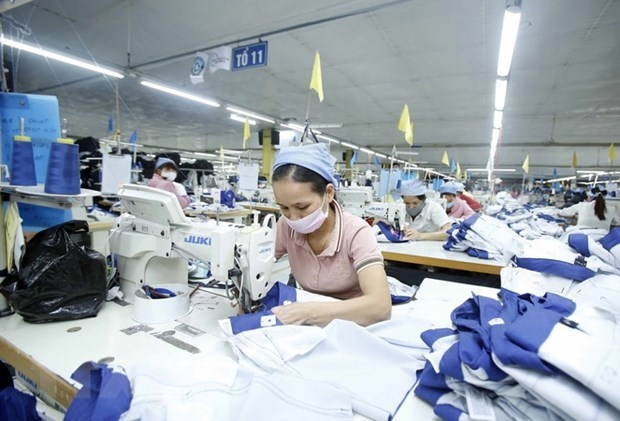Vietnam’s economy on course to record positive growth
While Vietnam is not out of the woods yet, it has enough pull factors to encourage investors to continue their business operations and even move their manufacturing operations to the country, according to Vietnam Briefing.
Economic activities gradually resuming
The news site noted that Vietnam has announced a phased plan to reopen the economy ensuring pandemic prevention in line with health authorities.
It reported that approximately two-thirds of industries in Ho Chi Minh City have reopened. The number of businesses in export processing zones and industrial parks in Ho Chi Minh City resuming operations has reached approximately 66% while at HCM City’s Saigon Hi-Tech park the rate is 74%.
Intel and Samsung are targeting to resume full operations of their factories in HCM City by the end of November, which may ease some disruption to supply chains.
Domestic flights are gradually resuming along with interprovincial road and rail travel though passengers have to be fully vaccinated to travel. Several localities have also reopened tourist sites in a bid to attract domestic tourists.
The government is also developing a roadmap to fully open up to international visitors by June 2022. The plan will be implemented in phases with a pilot programme for fully vaccinated international tourists to Phu Quoc island in November 2021. This is expected to be followed by Nha Trang, Ha Long, Hoi An, and Da Lat in December.
The government has issued a resolution on pandemic control giving guidance on four levels of transmission risk – low, moderate, high, and extremely high. The criteria based in the resolution are expected to be rolled out throughout the country which should make it easier for businesses to resume operations.
Apart from this, the government has introduced several measures to help businesses and individuals recover from COVID-19. These include land rent cuts, deferring tax and land payments, one-time payments for employees, and easing of some restrictions on foreign workers.
According to the news site, Vietnam’s market fundamentals remain strong and its economy appears resilient to overcome the recent disruption to production due to the pandemic. There are already signs that things are improving.
From October until the end of this year, 35 million doses of the COVID-19 vaccine are expected to be distributed throughout the country. While Vietnam had a slow start in vaccinating its population, as per Nikkei’s COVID-19 Recovery Index, Vietnam was among the top 10% of countries administering the most vaccine doses daily per capita.
In addition, Vietnam is also developing its own homegrown COVID-19 vaccines, which should be ready for use sometime next year. This would reduce Vietnam’s need to depend on foreign vaccines ensuring enough supply for the local population and also possibly export to other markets.
Recovery prospects
The Economist Intelligence Unit (EIU) of The Economist said the Vietnamese economy will recover swiftly in 2022, following the lifting of most coronavirus-related restrictions from late 2021.
Export-oriented manufacturing will continue to be the most important engine of economic growth.
Recent announcements made by foreign investors on additional investment to expand production in Vietnam reflect their trust in Vietnam’s prospects for economic recovery, reported the Dau tu (Investment Review) newspaper.
The Swiss company Nestle said it is pouring an additional over US$130 million, raising its total investment in Vietnam to US$730 million to carry out a number of its projects in the next two years.
Alongside Nestle, other foreign firms have committed to maintaining operations in Vietnam despite the fourth wave of COVID-19 outbreaks that have forced various localities to apply stringent preventive measures.
Tetra Pak of Sweden has confirmed that it will pump EUR5 million (US$5.86 million) to expand its existing EUR120 million plant in Binh Duong southern province.
The investment demonstrates the company’s trust in Vietnam’s strong economic recovery after the pandemic, according to Managing Director and President at Tetra Pak Vietnam Eliseo Barcas.
In particular, the LG Display project in Hai Phong northern port city has received additional investment twice this year, with US$750 million in February and US$1.4 billion in August.
Earlier this month, authorities in the northern province of Quang Ninh presented an investment registration certificate to a US$365.6 million project of Jinko Solar Vietnam Co. Ltd., an affiliate of the Jinko Solar Holding Co. Ltd. The firm channeled nearly US$500 million into a project in the province in March.
Despite current challenges triggered by the pandemic, Japanese firms in Vietnam are working to adapt and improve their production system in the new situation, said Chief Representative of the Japan External Trade Organisation (JETRO) in Hanoi Nakajima Takeo.
For his part, Alain Cany, Chairman of the European Chamber of Commerce (EuroCham) in Vietnam, said the European business community is determined to stand side by side with the Vietnamese Government in this tough time and believes that the Government will successfully bring COVID-19 under control like it did before.
As they have showed their determination to maintain operations in Vietnam, most foreign investors hope that the Government will promptly devise a clear plan for reopening and economic recovery, or else current investment plans will be delayed and newcomers cannot enter the country to study investment possibilities.
Despite COVID-19 impacts, foreign direct investment (FDI) inflows into Vietnam during the first nine months of this year rose 4.4% year on year to US$22.15 billion, reported the Foreign Investment Agency under the Ministry of Planning and Investment.
The total imports-exports value of the FDI sector in the first eight months of the year also surged 31.2% to US$297.43 billion, with exports accounting for US$156.64 billion.

